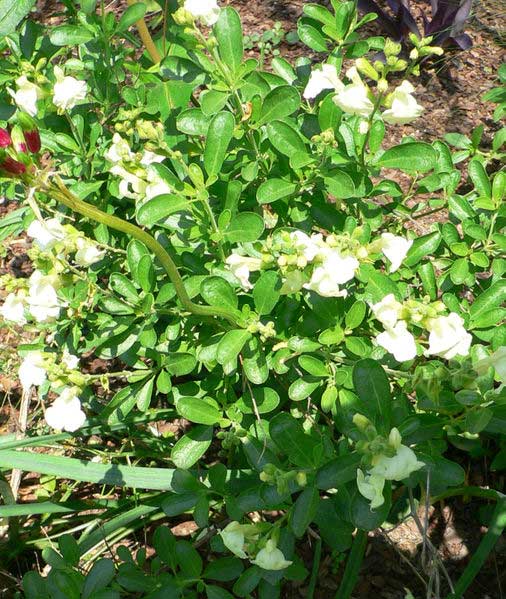
Salvia greggii (Photo: *)
Classification System: APG IV
Superregnum: Eukaryota
Regnum: Plantae
Cladus: Angiosperms
Cladus: Eudicots
Cladus: Core eudicots
Cladus: Asterids
Cladus: Lamiids
Ordo: Lamiales
Familia: Lamiaceae
Subfamilia: Nepetoideae
Tribus: Mentheae
Subtribus: Salviinae
Genus: Salvia
Subgenus: S. subg. Calosphace
Sectio: S. sect. Flocculosae
Species: Salvia greggii
Name
Salvia greggii A.Gray, Proc. Amer. Acad. Arts 8: 369 (1870).
Hybrids
Salvia × jamensis
Distribution
Native distribution areas:
References
Primary references
Gray, A., 1870. Proc. Amer. Acad. Arts 8: 369
Additional references
Govaerts, R.H.A. 2003. World Checklist of Selected Plant Families Database in ACCESS: 1-216203. The Board of Trustees of the Royal Botanic Gardens, Kew. [unavailable for the public] Reference page.
Links
Govaerts, R. et al. 2022. Salvia greggii in World Checklist of Selected Plant Families. The Board of Trustees of the Royal Botanic Gardens, Kew. Published online. Accessed: 2022 May 10. Reference page.
Hassler, M. 2022. Salvia greggii. World Plants: Synonymic Checklists of the Vascular Plants of the World In: Roskovh, Y., Abucay, L., Orrell, T., Nicolson, D., Bailly, N., Kirk, P., Bourgoin, T., DeWalt, R.E., Decock, W., De Wever, A., Nieukerken, E. van, Zarucchi, J. & Penev, L., eds. 2022. Species 2000 & ITIS Catalogue of Life. Published online. Accessed: 2022 May 10. Reference page.
Tropicos.org 2022. Salvia greggii. Missouri Botanical Garden. Published online. Accessed: 10 May 2022.
International Plant Names Index. 2022. Salvia greggii. Published online. Accessed: May 10 2022.
Vernacular names
English: Autumn sage
Salvia greggii, the autumn sage,[1] is a herbaceous perennial plant native to a long, narrow area from southwest Texas, through the Chihuahuan Desert and into the Mexican state of San Luis Potosi, typically growing in rocky soils at elevations from 5,000 to 9,000 ft (1,500 to 2,700 m). It was named and described in 1870 by botanist Asa Gray after Josiah Gregg (1806 – 1850), a merchant, explorer, naturalist, and author from the American Southwest and Northern Mexico, who found and collected the plant in Texas. It is closely related to, and frequently hybridizes with, Salvia microphylla. Despite the common name "autumn sage", it blooms throughout the summer and autumn.[2]
Description
Salvia greggii is a highly variable plant, with numerous named cultivars, reaching anywhere from 1 to 4 ft (0.30 to 1.22 m) in height and less in width. It can be either upright or mounding. The leaves are typically mid-green and glabrous, tending to be less than 1 in (2.5 cm) long, and with a spicy fragrance.[3] Flower size and color are extremely variable. Flowers reach from .25 to 1 in (0.64 to 2.54 cm) in length, and include many shades of scarlet and red (most common in the wild), along with rose, white, pink, lavender, apricot, and violet.[2]
Cultivation
The plant is used widely in horticulture. Popular named cultivars include 'Furman's Red', a cultivar from Texas that blooms profusely in autumn with dark red flowers. 'Big Pink' has a large lower lip with a deep pink color and lavender tint. 'Purple Pastel' is a small variety that repeat blooms in autumn. 'Cherry Chief 'blooms reliably in the humid southern United States. 'Desert Pastel' has pale apricot flowers with yellow streaks, and prefers mild climates.[2] Other cultivars include: 'Alba', a white flowered variety; 'Peach', with vivid red flowers; 'Strawberries and Cream', yellow and pink.[4]
Natural hybrids between S. greggii and S. microphylla were discovered in Mexico in 1991 by an English plant expedition. The variously colored hybrids are collectively named Salvia × jamensis after the nearest village, Jame. The collectors gathered seed from nearly 30 different colors of flowers. It was later discovered that plants collected in 1991 by collectors from Yucca Do Nursery in Texas were also forms of Salvia × jamensis. The various forms most resemble S. greggii in height, though they show a range of variety in other traits.[4] In the UK the cultivars ‘Javier’[5] and ‘Peter Vidgeon‘ have gained the Royal Horticultural Society’s Award of Garden Merit.[6][7]
Other species have been involved in the production of garden cultivars, and the precise origin of some is unclear. As a group, they may be referred to as Mexican salvias.[8]
'Coronado Pink'
'Teresa'
Notes
USDA, NRCS (n.d.). "Salvia greggii". The PLANTS Database (plants.usda.gov). Greensboro, North Carolina: National Plant Data Team. Retrieved 28 October 2015.
Clebsch, Betsy; Barner, Carol D. (2003). The New Book of Salvias. Timber Press. p. 136. ISBN 978-0-88192-560-9.
Welch, Dr. William C. (April 2008). "Autumn Sage: Salvia Greggii". Horticulture Update. Texas A & M University. Retrieved 19 May 2013.
Sutton, John (2004). The Gardener's Guide to Growing Salvias. Workman Publishing Company. pp. 118–120. ISBN 978-0-88192-671-2.
"RHS Plantfinder - Salvia × jamensis 'Javier'". Retrieved 14 October 2018.
"RHS Plantfinder - Salvia × Jamensis 'Peter Vidgeon'". Retrieved 14 October 2018.
"AGM Plants - Ornamental" (PDF). Royal Horticultural Society. July 2017. p. 94. Retrieved 14 October 2018.
Dyson, William (September 2015). "RHS trial of Mexican Salvia". The Plantsman. New Series. 14 (3): 158–164.
Retrieved from "http://en.wikipedia.org/"
All text is available under the terms of the GNU Free Documentation License

